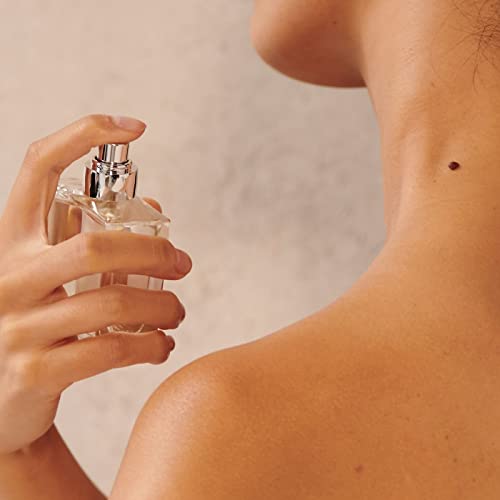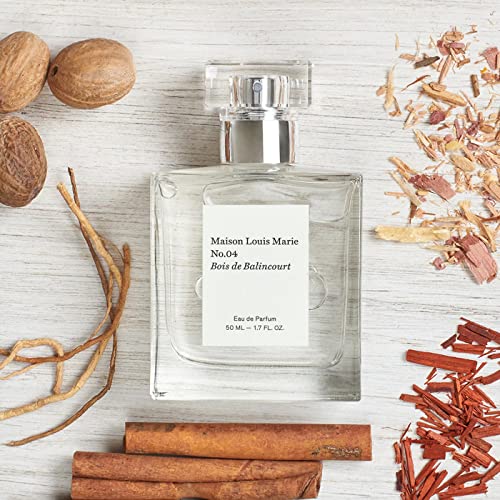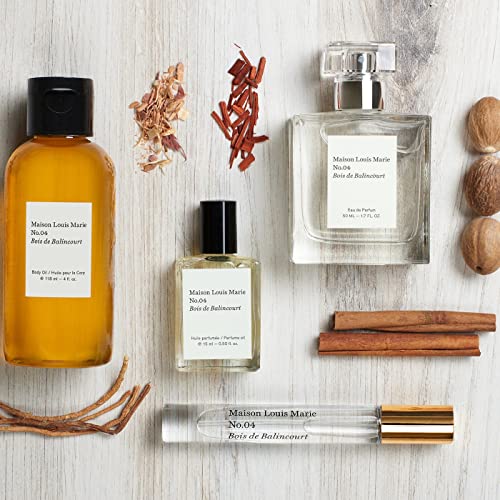






Maison Louis Marie Perfume - Sandalwood & Cedarwood Fragrance, Vegan & Non-Toxic - 1.7 fl oz


Geraniol
High RiskGeraniol is a naturally occurring scent ingredient commonly found in essential oils from plants such as geraniums and lemongrass. It is primarily used for its pleasant floral aroma in perfumes, cosmetics, and household products.
Sustai Insights
Geraniol serves as a fragrance component and offers a natural option for scenting products. However, it has a high allergenic potential and may cause skin irritation in sensitive individuals. While it is considered low risk for carcinogenicity and reproductive toxicity, regulatory bodies have placed restrictions on its use due to allergenic concerns. Overall, the assessment reflects a high-risk level, particularly for those prone to allergies, highlighting the need for caution in its application.
Lilial
High RiskLilial (butylphenyl methylpropanal) is a synthetic fragrance ingredient commonly used in personal care and cosmetic products to provide a floral scent. It is known for its aromatic properties and is often included in formulations to enhance sensory appeal.
Sustai Insights
Lilial offers functional benefits as an effective fragrance component, enhancing the sensory experience of products. However, it poses significant health risks, including a high allergenic potential and concerns regarding endocrine disruption, despite lower risks for carcinogenicity and reproductive toxicity. Environmental risks include potential pollution and bioaccumulation. Regulatory bodies have raised concerns, resulting in high usage restrictions. Overall, the assessment indicates a high-risk level, suggesting caution in its use and consideration of safer or more sustainable alternatives.
Fragrance
High RiskFragrance refers to a mixture of aromatic compounds used in products to provide scent. It is commonly listed as 'fragrance' or 'parfum' on product labels and can serve various functions, including enhancing user experience and masking undesirable odors.
Sustai Insights
Fragrance offers functional benefits by improving product appeal; however, it poses significant health risks, notably a high likelihood of causing allergies and allergic contact dermatitis. Environmental risks include potential pollution and endocrine disruption, though its overall carcinogenicity is low. Regulatory bodies have noted concerns regarding its use, leading to a high-risk classification. Safe usage practices should be observed, and alternatives such as natural essential oils are recommended for those sensitive to synthetic fragrances.
Limonene
Medium RiskLimonene is a scent ingredient and solvent naturally found in citrus fruits, commonly used in personal care and cleaning products for its fragrant properties. It serves as a flavoring agent and enhances the overall sensory experience of products.
Sustai Insights
Limonene offers functional benefits such as acting as a solvent and fragrance enhancer. However, it carries a high allergenic potential, which can trigger skin or respiratory sensitivities in some individuals. Environmental concerns include moderate persistence and bioaccumulation, along with potential ecotoxicity. Regulatory restrictions necessitate verification in products containing this ingredient. Overall, the risk level is assessed as medium, emphasizing the importance of cautious use, particularly for sensitive populations. Safer alternatives may be considered to mitigate these risks.
Water
Low RiskWater is a clear, colorless liquid essential for various biological processes. It serves as a solvent in formulations, facilitating the dissolution of other ingredients and enhancing product texture and application. Additionally, water plays a crucial role in hydration and is a key component in many cosmetic and personal care products.
Sustai Insights
Water is an effective solvent and hydrator, contributing to the texture and efficacy of formulations. It is biodegradable and generally regarded as safe, with low concerns regarding carcinogenicity, allergies, and reproductive toxicity. However, excessive water usage can lead to environmental concerns, particularly regarding resource depletion. Regulatory bodies do not impose restrictions on water use in cosmetics. Overall, the risks associated with water are low, making it a safe and essential ingredient.
Isoamyl Cinnamate
Low RiskIsoamyl cinnamate is an organic compound commonly used as a fragrance ingredient in personal care and cosmetic products. It is valued for its sweet, fruity scent that resembles banana and is often utilized in formulations to enhance aroma and consumer appeal.
Sustai Insights
Isoamyl cinnamate demonstrates functional benefits as a fragrance component without significant health risks, categorized under low concerns for carcinogenicity, allergies, and reproductive toxicity. Environmental risks are minimal, as it is not classified as a pollutant or bioaccumulative. Regulatory assessments indicate no current restrictions, supporting its safe usage in cosmetics. Overall, it presents a low risk, making it a viable option in formulation, although alternatives should still be considered for sustainability.
Alcohol Denatured
Low RiskAlcohol denatured, also known as specially denatured (SD) alcohol, is a mixture of ethanol and other substances that render it unsuitable for consumption. It is commonly used in cosmetic and personal care products as a solvent, preservative, and penetration enhancer, facilitating the absorption of other ingredients.
Sustai Insights
Alcohol denatured offers functional benefits as a solvent and preservative, aiding in the formulation of various products. It is not associated with significant health risks, with low concerns regarding carcinogenicity, allergies, and reproductive toxicity. Environmental risks are minimal, and it is not classified as a pollutant. Regulatory bodies do not impose major restrictions on its use, indicating a low overall risk level. Safe usage practices should be followed to minimize exposure, and alternative solvents can be considered for those seeking greener options.
Water
Low RiskWater is a clear, colorless liquid essential for various biological processes. It serves as a solvent in formulations, facilitating the dissolution of other ingredients and enhancing product texture and application. Additionally, water plays a crucial role in hydration and is a key component in many cosmetic and personal care products.
Sustai Insights
Water is an effective solvent and hydrator, contributing to the texture and efficacy of formulations. It is biodegradable and generally regarded as safe, with low concerns regarding carcinogenicity, allergies, and reproductive toxicity. However, excessive water usage can lead to environmental concerns, particularly regarding resource depletion. Regulatory bodies do not impose restrictions on water use in cosmetics. Overall, the risks associated with water are low, making it a safe and essential ingredient.
Isoamyl Cinnamate
Low RiskIsoamyl cinnamate is an organic compound commonly used as a fragrance ingredient in personal care and cosmetic products. It is valued for its sweet, fruity scent that resembles banana and is often utilized in formulations to enhance aroma and consumer appeal.
Sustai Insights
Isoamyl cinnamate demonstrates functional benefits as a fragrance component without significant health risks, categorized under low concerns for carcinogenicity, allergies, and reproductive toxicity. Environmental risks are minimal, as it is not classified as a pollutant or bioaccumulative. Regulatory assessments indicate no current restrictions, supporting its safe usage in cosmetics. Overall, it presents a low risk, making it a viable option in formulation, although alternatives should still be considered for sustainability.
Geraniol
High RiskGeraniol is a naturally occurring scent ingredient commonly found in essential oils from plants such as geraniums and lemongrass. It is primarily used for its pleasant floral aroma in perfumes, cosmetics, and household products.
Sustai Insights
Geraniol serves as a fragrance component and offers a natural option for scenting products. However, it has a high allergenic potential and may cause skin irritation in sensitive individuals. While it is considered low risk for carcinogenicity and reproductive toxicity, regulatory bodies have placed restrictions on its use due to allergenic concerns. Overall, the assessment reflects a high-risk level, particularly for those prone to allergies, highlighting the need for caution in its application.
Alcohol Denatured
Low RiskAlcohol denatured, also known as specially denatured (SD) alcohol, is a mixture of ethanol and other substances that render it unsuitable for consumption. It is commonly used in cosmetic and personal care products as a solvent, preservative, and penetration enhancer, facilitating the absorption of other ingredients.
Sustai Insights
Alcohol denatured offers functional benefits as a solvent and preservative, aiding in the formulation of various products. It is not associated with significant health risks, with low concerns regarding carcinogenicity, allergies, and reproductive toxicity. Environmental risks are minimal, and it is not classified as a pollutant. Regulatory bodies do not impose major restrictions on its use, indicating a low overall risk level. Safe usage practices should be followed to minimize exposure, and alternative solvents can be considered for those seeking greener options.
Lilial
High RiskLilial (butylphenyl methylpropanal) is a synthetic fragrance ingredient commonly used in personal care and cosmetic products to provide a floral scent. It is known for its aromatic properties and is often included in formulations to enhance sensory appeal.
Sustai Insights
Lilial offers functional benefits as an effective fragrance component, enhancing the sensory experience of products. However, it poses significant health risks, including a high allergenic potential and concerns regarding endocrine disruption, despite lower risks for carcinogenicity and reproductive toxicity. Environmental risks include potential pollution and bioaccumulation. Regulatory bodies have raised concerns, resulting in high usage restrictions. Overall, the assessment indicates a high-risk level, suggesting caution in its use and consideration of safer or more sustainable alternatives.
Limonene
Medium RiskLimonene is a scent ingredient and solvent naturally found in citrus fruits, commonly used in personal care and cleaning products for its fragrant properties. It serves as a flavoring agent and enhances the overall sensory experience of products.
Sustai Insights
Limonene offers functional benefits such as acting as a solvent and fragrance enhancer. However, it carries a high allergenic potential, which can trigger skin or respiratory sensitivities in some individuals. Environmental concerns include moderate persistence and bioaccumulation, along with potential ecotoxicity. Regulatory restrictions necessitate verification in products containing this ingredient. Overall, the risk level is assessed as medium, emphasizing the importance of cautious use, particularly for sensitive populations. Safer alternatives may be considered to mitigate these risks.
Fragrance
High RiskFragrance refers to a mixture of aromatic compounds used in products to provide scent. It is commonly listed as 'fragrance' or 'parfum' on product labels and can serve various functions, including enhancing user experience and masking undesirable odors.
Sustai Insights
Fragrance offers functional benefits by improving product appeal; however, it poses significant health risks, notably a high likelihood of causing allergies and allergic contact dermatitis. Environmental risks include potential pollution and endocrine disruption, though its overall carcinogenicity is low. Regulatory bodies have noted concerns regarding its use, leading to a high-risk classification. Safe usage practices should be observed, and alternatives such as natural essential oils are recommended for those sensitive to synthetic fragrances.
Discover the enchanting aroma of Maison Louis Marie - No.04 Bois de Balincourt Natural Eau de Parfum Spray, a luxurious, clean beauty fragrance that embodies the spirit of nature. This non-toxic perfume, inspired by the mystical woods surrounding the family home, blends warm sandalwood and earthy cedarwood with spicy cinnamon and nutmeg notes for a captivating scent experience.
- Romantic Fragrance Profile: A perfect harmony of sandalwood and cedarwood with hints of vetiver and nutmeg, creating a unique and inviting scent.
- Eco-Friendly Commitment: Vegan and cruelty-free, Maison Louis Marie ensures that every spray is mindful of your body and the environment.
- Long-Lasting Aroma: Apply to pulse points for a fragrance that enhances with your body heat, ensuring a delightful scent throughout the day.
- Versatile Use: Ideal for any occasion, this fragrance can be layered with body lotions for added depth and complexity.
- Quality Ingredients: Crafted with natural components, the formula is free from harmful toxins, promoting a healthier choice for fragrance lovers.
Subscribe & Save with Sustai
- Best Price Guarantee: Always enjoy the lowest prices on sustainable home essentials.
- No Surprises: We’ll notify you before shipping. No hidden fees, ever.
- You’re in Charge: Change, pause, or cancel your subscription anytime with ease.
- Eco-Friendly Deliveries: Our grouped shipments mean less packaging and lower emissions.
Join us on a sustainable journey. Special offers for a limited time! Prices and promotions may change.
Recommended Products
Discover the enchanting aroma of Maison Louis Marie - No.04 Bois de Balincourt Natural Eau de Parfum Spray, a luxurious, clean beauty fragrance that embodies the spirit of nature. This non-toxic perfume, inspired by the mystical woods surrounding the family home, blends warm sandalwood and earthy cedarwood with spicy cinnamon and nutmeg notes for a captivating scent experience.
- Romantic Fragrance Profile: A perfect harmony of sandalwood and cedarwood with hints of vetiver and nutmeg, creating a unique and inviting scent.
- Eco-Friendly Commitment: Vegan and cruelty-free, Maison Louis Marie ensures that every spray is mindful of your body and the environment.
- Long-Lasting Aroma: Apply to pulse points for a fragrance that enhances with your body heat, ensuring a delightful scent throughout the day.
- Versatile Use: Ideal for any occasion, this fragrance can be layered with body lotions for added depth and complexity.
- Quality Ingredients: Crafted with natural components, the formula is free from harmful toxins, promoting a healthier choice for fragrance lovers.

You can have at most 2 Sustainable Steals products in your cart
Customer Reviews
Customers’ View
Customers appreciate the unique and light scent of Maison Louis Marie's No.04 Bois de Balincourt, describing it as an enchanting blend of earthy and spicy notes that evoke a walk through a fragrant garden. Many users highlight the fragrance's ability to garner compliments, with one noting it has become their favorite perfume. However, opinions on its longevity vary; while some find it lasts all day, others feel it is too subtle and weak. Additionally, customers express dissatisfaction with the return policy, noting the lack of options for returns or exchanges. Importantly, the product is considered an eco-conscious choice, being vegan and cruelty-free, which resonates with environmentally and health-conscious consumers. Overall, customers find this fragrance captivating yet acknowledge some areas for improvement.
AI-generated from the text of customer reviewsThis product is rated 5.0 of 5.0 stars.
It has received 2 reviews.




